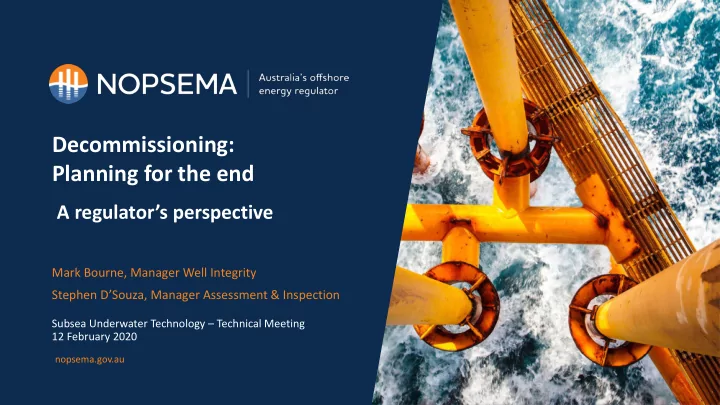

Decommissioning: Planning for the end A r egulator’s perspective Mark Bourne, Manager Well Integrity Stephen D’Souza, Manager Assessment & Inspection Subsea Underwater Technology – Technical Meeting 12 February 2020 nopsema.gov.au
Objective Outline regulatory requirements and considerations for field retirements and decommissioning offshore Australia (Commonwealth waters)
Contents 1. Background 2. Legislation & regulations 3. Standard, guidelines, policies 4. Well abandonments 5. WOMP compliance 6. Environment plans - Decommissioning 7. Issues & risk with delay 8. Opportunities & challenges 9. Collaboration 10. Questions
Background • Upcoming worldwide wave of O&G field retirements and decommissioning • Field decommissioning (incl wells’ P&A) offshore Australia in Commonwealth waters over recent years include: Griffin, Jabiru / Challis, Puffin, Mackerel, Black Back • Around 900 wells still remain offshore Australia Platform and SS developments E&A wells not yet abandoned
Background
OPGGS Act 2006 Section 572 • Titleholder must maintain in good condition all structures, equipment and other property in the title area used in connection with authorised operations. • Titleholder must remove from title area all structures, equipment and other property neither used nor to be used in connection with authorised operations. Sections 166 & 587 • If no petroleum recovery operations carried out for 5 years, the Joint Authority can terminate the licence • If permit / lease / licence has been terminated / expired etc, NOPSEMA can direct (former) titleholder to remove all property and plug or close off all wells.
OPGGS Act 2006 Minister’s directive (Oct 2019): “I ask that NOPSEMA give heightened focus to oversight of titleholders’ compliance with OPGGS Act Section 572 obligations in relation to maintenance and removal of property and equipment brought onto title ” .
OPGGS (RMA) Regulations 2011 Part 2.12 – Surrender of titles Joint Authority may consent to surrender title only if the registered holder of the permit, lease or licence: ………… • Has, to the satisfaction of NOPSEMA : Removed …….. all property in the surrender area or made other arrangements Plugged or closed off all wells …….. Made good any damage to the seabed or subsoil ……….
Standards, Guidelines, Policies Standards, guidelines and other policies concerning well decommissioning include: • Oil and Gas UK Well Decommissioning Guidelines • Oil and Gas Authority (UK regulator) General consent period for well suspension – 2 yrs • US Bureau of Safety & Environmental Enforcement (BSEE) “Idle Iron Policy” Any well “idle” or not useful ….. expected to be plugged no later than 3 years after becoming “idle”. • NORSOK D-010 Max duration for a well temp abandoned without monitoring – 3 yrs • ISO 16530-1 Well should not remain suspended indefinitely
Well Abandonment Wells’ final abandonments: • Concerned with isolation of formations with flow potential • Prevent flow from, or into wells, or between formations • Re-instate integrity of sealing formations (cap rock, intermediate zones) • Robust and reliable over the long term, in perpetuity or geologic time
Well Abandonment Illustration - restoring cap rock integrity
WOMP Compliance Well Operations Management Plan (WOMP) assessment is the main mechanism for verifying P&A compliance with legislation.
Environment Plans - Decommissioning The process of removing or otherwise satisfactorily dealing with offshore infrastructure in a safe and environmentally responsible manner, at the end of its useful life • The permit holder (company) is responsible. Complete removal of property and the P&A of wells is base case • Environment Plan - Impacts and risks of removal or proposed alternative must meet the EP regulatory criteria to be acceptable to NOPSEMA • Alternatives to removal - Address long term (in perpetuity) impacts and risks to the marine environment (ecology, invasive species, stakeholder consultation) Effects of material degradation over time Effects of contaminants, eg NORM, Mercury • Scientific uncertainty: Collaborative industry approach to building an evidence base to address uncertainty
Issues & risks with delays • Deterioration of asset integrity Infrastructure instability Well integrity - potential for leaks • Equipment obsolescence OEM equipment and parts no longer available • Modern BOPs & risers too heavy for old wellheads • Loss of records and knowledge File systems replaced, personnel retirements Increase in scope, risk, cost, uncertainty
Opportunities & Challenges • Design, install and operate ‘property’ with the intention of removal • Maintain property in good condition and repair until it is removed – s572 of OPGGS Act • Early planning - Decommissioning plans prepared and accepted prior to the cessation of production • Remove property from the title area when it is neither used nor to be used – s572 obligation applies throughout the lifecycle of a project • New entrants where late life operations are dependant on field performance and ongoing integrity of ageing facilities
Collaboration • Global initiatives in place to address offshore decommissioning challenges • NOPSEMA is member of International Regulators Forum (IRF) • NOPSEMA also involved locally: Curtin University well decommissioning advisory committee APPEA DISC steering group on well decommissioning • Industry collaboration is essential for efficient and reliable decommissioning challenges ahead R&D, new technologies Equipment and resources sharing Lessons learned
Questions
National Offshore Petroleum Safety and Environmental Management Authority Level 8 Alluvion, 58 Mounts Bay Rd, Perth WA 6000 GPO Box 2568, Perth WA 6001 Australia nopsema.gov.au
Recommend
More recommend